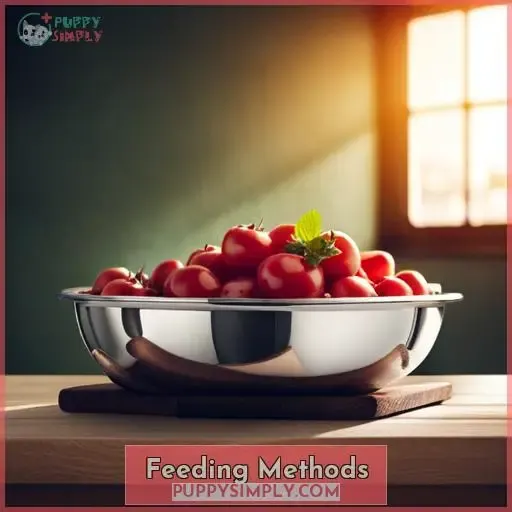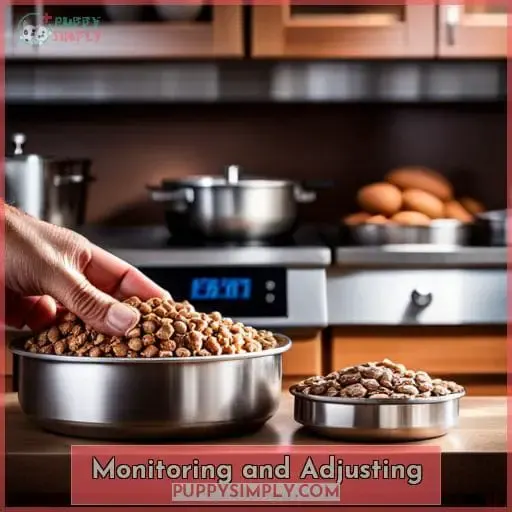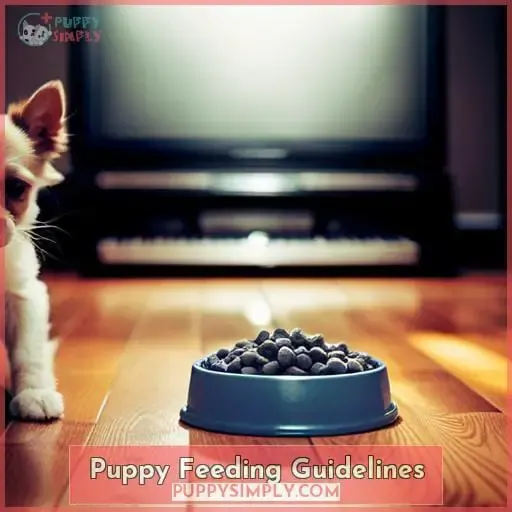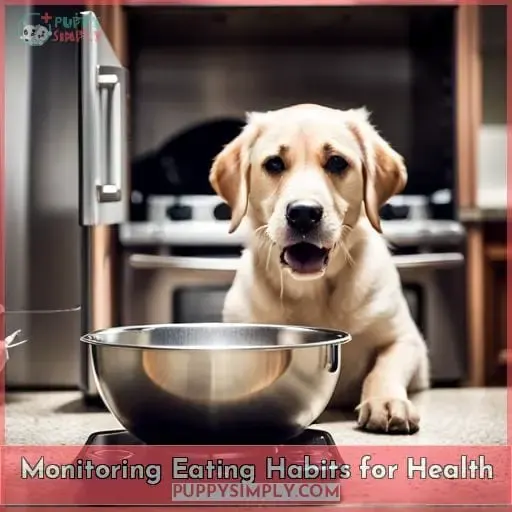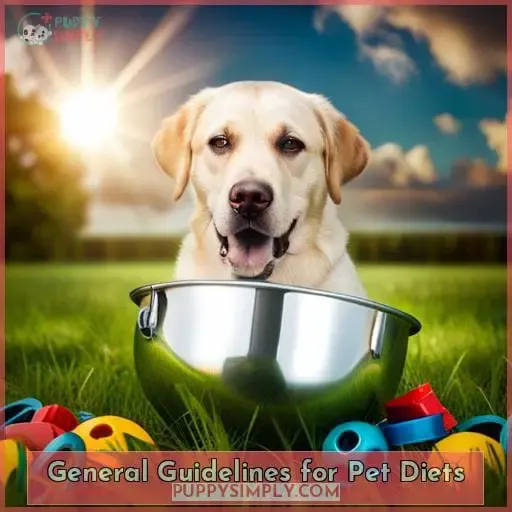This site is supported by our readers. We may earn a commission, at no cost to you, if you purchase through links.
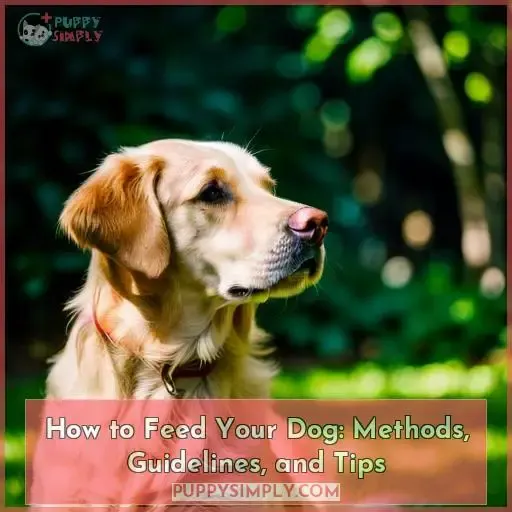 Feel like you’re depriving your furry friend with just one or two scoops of dry kibble? Don’t worry, there are plenty of healthy ways to feed your dog! From free-choice feeding to portion control and timed feeding methods, you have options.
Feel like you’re depriving your furry friend with just one or two scoops of dry kibble? Don’t worry, there are plenty of healthy ways to feed your dog! From free-choice feeding to portion control and timed feeding methods, you have options.
In this article, we’ll explore different feeding methods, guidelines, and tips that will help ensure your dog’s nutritional needs are met while keeping them happy and healthy.
Table Of Contents
- Key Takeaways
- Feeding Methods
- Monitoring and Adjusting
- Important Considerations
- Importance of Establishing a Feeding Routine
- Puppy Feeding Guidelines
- Number of Meals and Meal Timing
- Dealing With Picky Eaters and Grazers
- Monitoring Eating Habits for Health
- General Guidelines for Pet Diets
- Cat-Specific Diet Recommendations
- Frequently Asked Questions (FAQs)
- Conclusion
Key Takeaways
- Control portions and avoid free-choice feeding to prevent overeating
- Provide at least two meals daily, spaced about 12 hours apart
- Monitor weight fluctuations and behavior changes to tailor feeding
- Address picky eating through enrichment and gradual exposure to new foods
Feeding Methods
When it comes to feeding your dog, there are several methods you can choose from.
- Free-choice feeding involves leaving dry food out all day for healthy and active dogs.
- The portion control method requires determining your dog’s ideal weight and following the instructions on the bag.
- Another option is timed feeding, where you allocate a specific time frame for your dog to eat and discard any leftovers afterwards.
Finally, it’s important to give treats in moderation as they should only make up 5-10% of your dog’s daily diet.
Free-choice Feeding
To free-choice feed your dog, leave dry food out all day for them to eat whenever they’re hungry.
- Attracting insects
- Pet conflicts
- Enabling dogs prone to overeating
It’s also not ideal for diabetic dogs or those needing more controlled portion sizes and regular mealtimes per veterinary guidance.
Portion Control Method
Determine the dog’s ideal weight and follow the bag instructions when establishing portion control feeding. This method involves dividing the suggested amount of food into two feedings, 8-12 hours apart.
It’s important to consult a vet for precise feeding calculations as some commercial food labels may suggest more than necessary.
Portion control helps with nutritional balancing, weight management, and allows for regular health monitoring and dietary adjustments under veterinary care.
Timed Feeding Method
Set a specific time for your dog to eat and discard any uneaten food after the designated time.
The timed feeding method involves offering a set timeframe, usually around 30 minutes, for your dog to finish their meal.
It helps establish regular feeding schedules, which can have positive behavioral impacts on dogs.
Additionally, it promotes portion control and prevents overeating or grazing throughout the day.
Consistency in feeding times also aids in training and reinforces discipline with meals.
Treats in Moderation
When providing treats, limit them to only 5-10% of your dog’s total daily diet.
Treat selection is important for maintaining calorie balance and promoting healthy eating habits.
Consider the nutritional needs of your dog when choosing treats and ensure they’re appropriate for their size, age, and activity level.
Using small pieces as training rewards can be effective in reinforcing desired behaviors.
Be mindful of potential health implications or behavioral effects from excessive treat consumption, especially if your dog has food allergies.
Monitoring and Adjusting
You’ll need to continually evaluate your dog’s appetite and behavior around mealtimes.
Monitor changes in activity levels or health that could impact their calorie needs, but also assess if food requests reflect hunger or a bid for attention.
Adjust both the feeding amount and your own responses accordingly.
Monitor Changes
You’ll need to monitor any changes in your dog’s activity level, health, or environmental conditions and adjust their food quantity accordingly.
- Track weight fluctuations, as these may reflect over or underfeeding.
- Consider variations in weather, as dogs require more calories in cold temperatures.
- Evaluate behavioral changes like increased agitation or lethargy, as these could stem from inappropriate nutrition.
Make judicious dietary adjustments based on health indicators to optimize your dog’s wellbeing.
Attention Vs. Hunger
To monitor your dog’s eating habits effectively, it’s important to distinguish between attention-seeking behavior and genuine hunger.
Look for behavioral cues signaling emotional needs versus nutritional needs.
While bonding through food meets some needs, focus more on providing affection.
Use food toys and bones on a regular routine to meet nutritional needs rather than emotional feeding.
Understanding true cravings guides appropriate responses.
Important Considerations
When determining how to appropriately feed your dog, there are several key general guidelines, training treat recommendations, and professional veterinary directions to consider.
Following commercial pet food labels provides a helpful starting point, though adjustments based on your dog’s hunger cues and weight are often necessary.
Consulting your veterinarian allows for tailored advice regarding your dog’s specific dietary needs and overall health.
General Guidelines
Your general guidelines include using the labels as a baseline, monitoring weight gain, and recognizing some dogs act perpetually hungry regardless of actual needs.
- Consult veterinarians to determine ideal weights and nutritional needs.
- Weigh dogs regularly to track weight fluctuations indicating overfeeding.
- Note behavior changes suggestive of emotional issues rather than hunger.
- Adjust food amounts gradually and consistently to meet changing dietary requirements.
Treats for Training
Optimizing treat size and frequency enables effective training for your dog.
- Use very small treat pieces for frequent training sessions.
- Set aside a portion of daily kibbles for use as training treats.
- Ensure treats contribute to only 5-10% of your dog’s daily diet.
- Adapt treat quantity based on your dog’s weight and activity level to optimize positive reinforcement strategies.
- Consistent training regimens strengthen the owner-dog relationship.
Veterinary Guidance
Consulting your vet for specific feeding recommendations ensures your dog’s diet aligns with their overall health and wellness.
Seek advice on your dog’s ideal weight and precise daily food amounts.
Consider professional guidance for dogs with health conditions.
Regularly update the vet on diet or behavior changes.
Ensure feeding practices support your dog’s physical and emotional well-being through veterinary consultations tailored to their needs.
Importance of Establishing a Feeding Routine
Establishing a consistent feeding routine benefits your dog by:
- Aiding in house training
- Providing security through predictability
- Facilitating necessary dietary changes
- And more.
Mealtime stability creates a sense of comfort for your dog, reducing anxiety and promoting overall well-being.
A feeding schedule helps prevent digestive issues such as hyperacidic stomach or food intolerances.
Daily predictability allows for better monitoring of appetite and can help identify any potential health concerns.
By establishing a feeding routine for your dog, you’re giving them the structure they need to thrive. It provides them with consistency and stability in their daily lives while also ensuring that their nutritional needs are met.
Whether it’s raw dog food or senior cat diet options that require specific meal times or portion control methods for dogs with certain dietary restrictions – having an established feeding schedule is crucial.
Puppy Feeding Guidelines
Now that you understand the importance of establishing a feeding routine, let’s dive into puppy feeding guidelines.
Feeding your puppy properly is crucial for their growth and development. Puppies have specific nutritional requirements due to their rapid growth patterns and dietary development needs.
It is important to avoid ad libitum or free choice feeding for puppies as it can lead to overeating and disrupt genetically determined adult size. Controlled portions prevent slower digestion and discomfort in growing puppies. Regular feeding times contribute to healthier puppy development by providing structure and consistency.
To ensure optimal nutrition, consult with your veterinarian about the appropriate caloric intake for your puppy based on their breed, age, weight, activity level, and overall health condition.
Properly nourishing your pup promotes digestive health while setting them up for a healthy adulthood.
Number of Meals and Meal Timing
Make sure you provide your dog with at least two meals per day, approximately 12 hours apart.
- Maintaining their digestive health
- Meeting their nutritional needs
- Accommodating their behavioral patterns
Dogs thrive on routine and consistency when it comes to mealtime. By offering them regular meals throughout the day, you’re helping them establish a sense of predictability in terms of food availability.
Additionally, providing two meals spaced evenly apart allows dogs to have consistent energy levels throughout the day without experiencing prolonged periods of hunger or overeating due to extended gaps between feedings.
Pay attention to your dog’s appetite cues and adjust portion sizes accordingly while adhering to a consistent meal schedule for optimal well-being.
Dealing With Picky Eaters and Grazers
You’ll find establishing mealtime expectations beneficial for all dogs when dealing with picky eaters and grazers.
For grazers, measure the entire day’s food portion in the morning to control consumption while providing needed nutrients.
Food toys also facilitate healthier eating habits by encouraging natural foraging behaviors.
As cues arise indicating preference shifts, adapt to new foods through scheduled training interactions.
Monitor behavioral signals to identify optimal times for dietary adjustments supporting your dog’s unique needs.
Addressing preferences through enrichment enables both dietary control and mental stimulation.
Monitoring Eating Habits for Health
Monitor your dog’s eating habits regularly to ensure their health and well-being.
- Pay attention to changes in eating behavior like unfinished meals or altered appetite, as these can indicate illness
- Note differences in dietary patterns over time to identify potential health issues
- Use consistent mealtimes as opportunities to assess your dog’s health
- Track nutritional intake to make informed decisions about diet adjustments
Regular observation of your dog during feeding times allows you to recognize disruptions in eating routines crucial for early identification of medical conditions. Feeding schedules also serve as bonding times, enhancing the relationship between you and your dog.
General Guidelines for Pet Diets
After monitoring your dog’s eating habits for health, you should adhere to some general guidelines when considering pet diets overall.
It’s important to prioritize nutritional balance in their meals. While homemade preparations can be an option, it’s crucial to consult a vet before making any changes.
When preparing meals at home, ensure that the ingredients used are safe for dogs and avoid toxic foods such as chocolate, macadamia nuts, grapes, onions, garlic, alcohol caffeine,and artificial sweeteners.
For allergy management purposes consider using limited ingredient diets or specialized hypoallergenic food options recommended by your vet.
Weight regulation is another key aspect of pet diets. Adjusting portion sizes based on size,
age and activity level will help maintain a healthy weight for your dog.
By following these general guidelines regarding nutritional balance,
homemade preparations,safe ingredients , allergy management
and weight regulation,you can provide your furry friend with a well-rounded diet that supports their overall health and wellness.
Cat-Specific Diet Recommendations
First, establish specific meal times for your cat to control portions effectively.
Since senior cats are less active, their calorie needs decrease. However, their nutritional needs remain the same or may even increase.
Feed senior cats smaller, more frequent meals to aid digestion. For example, provide three or four evenly spaced feedings throughout the day.
Stick to scheduled meal times rather than free-choice feeding to facilitate weight management.
Monitor your cat’s body condition score and intake. Adjust portions or feed a senior-specific food as needed to meet changing nutritional requirements while preventing obesity.
Frequently Asked Questions (FAQs)
Can I feed my dog table scraps or human food?
You can occasionally feed small amounts of plain cooked meat, vegetables, rice or pasta as treats, but they shouldn’t exceed 10% of daily calories.
Focus on quality commercial dog food for balanced nutrition and use treats sparingly to avoid obesity or other health issues.
Consult your vet.
How do I determine the appropriate portion size for my dog?
Base your dog’s portions on the guidelines on its food’s packaging or from your vet, adjusted for your dog’s ideal weight.
Then monitor your dog’s body condition and adjust amounts accordingly if needed to maintain an ideal weight.
Should I be concerned if my dog always appears hungry?
One out of three pet dogs is estimated to be overweight.
If your dog persistently acts hungry despite proper portion sizes, consult your veterinarian to rule out any medical issues.
Determining the appropriate amount to feed remains imperative for your dog’s health.
What should I do if my dog refuses to eat their food?
If your dog refuses their food,
- Withhold food for 12 hours then reoffer.
- If still refusing, try warming the food or adding low-sodium broth.
- Persistent refusal warrants a veterinary visit to check for underlying illness.
- Switch brands or textures if your vet finds no medical issues.
Are there any foods that are toxic or harmful to dogs that I should avoid feeding them?
To ensure your dog’s well-being, be cautious of toxic foods like chocolate, grapes, onions, garlic.
Opt for safe options such as lean meats or cooked veggies.
Prioritize their health by avoiding harmful substances in their diet.
Conclusion
Ultimately, the key to properly feeding your dog lies in finding the method that works best for their individual needs.
There are various options to explore, whether it’s free-choice feeding, portion control, or timed feeding.
Monitoring your dog’s changes, establishing a feeding routine, and seeking veterinary guidance are all important considerations.
Additionally, paying attention to the number of meals and meal timing, dealing with picky eaters, and monitoring eating habits for optimal health are crucial.
By following these guidelines, you can ensure that your furry friend receives the nutrition they need to thrive.

